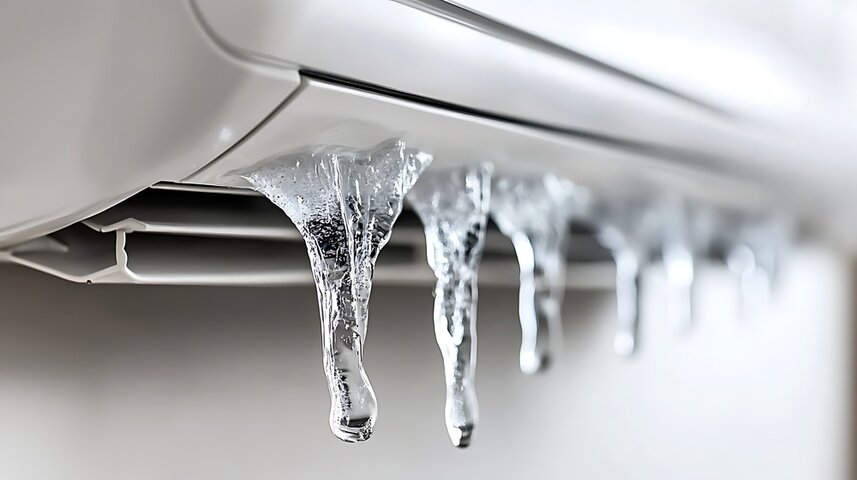AC Unit Ice Buildup Las Cruces. In the sun-drenched city of Las Cruces, New Mexico, where summer temperatures often reach triple digits, a properly functioning air conditioning unit is not a luxury—it’s a necessity. Therefore, if you notice ice forming on your AC unit, it is a cause for significant concern. This condition not only indicates a problem but also severely hinders the ability to cool your home, leading to discomfort and potentially costly damage. Every homeowner in Las Cruces needs to understand why ice forms, how to prevent it, and the best ways to address it.
What is AC Unit Ice Buildup and Why Does It Happen?
Ice buildup on your AC unit, often visible on the outdoor unit’s refrigerant lines or the indoor evaporator coil, indicates a problem with the unit’s normal heat exchange process. Air conditioners work by absorbing heat from the indoor air using a cold refrigerant and then releasing it outside. If the refrigerant isn’t absorbing enough heat, or if the airflow is restricted, the evaporator coil gets too cold, dropping below freezing point, causing condensation on the coil to freeze.
Several common issues can lead to this chilling problem:
Low Refrigerant Levels (Leaky System): This is one of the most frequent culprits. If your AC unit is low on refrigerant (due to a leak), the pressure in the system drops. Lower pressure means the refrigerant temperature drops significantly, causing the evaporator coil to become excessively cold – below freezing – and freeze the condensation that collects on it.
Restricted Airflow: The evaporator coil needs warm air flowing over it to properly absorb heat and prevent freezing. Any obstruction to this airflow can cause the coil to get too cold. Common airflow restrictions include:
Dirty Air Filters: A clogged air filter is a very common and easily preventable cause. It chokes the airflow to the evaporator coil.
Blocked Return Vents: Furniture, drapes, or debris blocking return air vents can restrict the amount of warm air reaching the unit.
Blocked Supply Vents: While less direct, severely blocked supply vents can also create pressure imbalances.
Closed Registers: Closing too many registers in certain rooms can sometimes lead to airflow issues in the system as a whole.
Obstructed Evaporator Coil: Dirt, dust, and grime can accumulate on the evaporator coil itself, acting as an insulating layer and preventing proper heat exchange, leading to freezing.
Malfunctioning Blower Fan: The blower fan is responsible for moving air across the evaporator coil. If it’s not working correctly (e.g., set too low, failing motor, damaged fan blade), airflow will be insufficient, leading to freezing.
Dirty Outdoor Condenser Coils: While typically causing overheating, a severely dirty outdoor coil can indirectly contribute by causing the whole system to work harder, which can sometimes lead to imbalances that affect the indoor coil’s temperature.
Faulty Thermostat: A malfunctioning thermostat might not be signaling the AC unit correctly, causing it to run continuously or cycle improperly, leading to freezing.
Clogged Condensate Drain Line: When the condensate drain line gets clogged with algae or debris, the water can back up and overflow, eventually freezing around the coil or in the drain pan.
How to Stop Ice from Forming in AC
If you discover ice on your AC unit, the first and most crucial step is to turn off your air conditioner immediately. Continuing to run a frozen unit can cause severe and expensive damage to critical components, especially the compressor. Once the unit is off, allow it to defrost naturally. This can take several hours, or even a full day, depending on the severity of the ice.
While it defrosts, you can begin to investigate and address the underlying issues:
Check and Replace Air Filters: This is the easiest and most common fix. Inspect your air filter. If it’s dirty, replace it with a clean one. Aim to check and replace your filter every 1-3 months, especially during peak cooling season in Las Cruces.
Inspect and Clear Vents: Ensure all return air vents are unobstructed by furniture, drapes, or anything else. Also, make sure that most of your supply vents are open. Avoid closing too many vents, as this can upset the system’s airflow balance.
Clean Outdoor Condenser Coils: Use a hose to gently spray down the fins of your outdoor unit, removing any accumulated dirt, leaves, or debris. Make sure the unit is off before you do this.
Check for Leaks Around the Indoor Unit: While the unit is defrosting, look for water pooling around the indoor unit or in the condensate drain pan, which could indicate a clogged drain line. If you can access it, try to clear the drain line gently with a wet/dry vac or a thin brush.
Listen to Your Blower Fan: Turn on just the fan setting on your thermostat (not the AC) to ensure the blower fan is operating correctly and pushing a good volume of air.
If the problem persists after these steps, or if you suspect low refrigerant levels, a clogged drain line you can’t clear, or a faulty component, it’s time to call a professional HVAC technician. Trying to fix a refrigerant leak or a complex mechanical issue yourself can be dangerous and lead to further damage. Given Las Cruces’s climate, prompt professional service is essential.
Can I Turn on Heat to Defrost AC?
This is a common question, and the answer is generally yes, you can turn on your heat to defrost your AC unit, but with a crucial caveat.
The goal is to get warm air moving over the frozen evaporator coil to melt the ice quickly. By turning your thermostat to “Heat” mode and setting the temperature above your current room temperature, your furnace (or heat pump, if you have one) will activate and blow warm air through your ductwork, directly over the now-frozen evaporator coil.
Here’s the crucial caveat: You should only do this after you’ve turned off the cooling function of your AC unit and allowed the compressor to completely shut down for at least 1-2 hours. You don’t want the AC system trying to run in reverse or battling the heat. The idea is to use the furnace’s blower fan to accelerate the defrosting process, not to fight against an active cooling cycle.
Steps to defrost with heat:
Turn off your AC unit at the thermostat and potentially the breaker.
Wait 1-2 hours for the compressor to de-pressurize and the system to rest.
Set your thermostat to “Heat” mode.
Increase the temperature setting significantly above your current room temperature to ensure the heat kicks on.
Allow the heat to run until all the ice has melted. You might hear dripping as the ice melts.
Once defrosted, turn the thermostat back to “Off” and wait another hour or two before attempting to restart your AC in cooling mode, after you’ve addressed potential causes like a dirty filter.
Using the heat to defrost can significantly speed up the process, often reducing defrost time from many hours to just one or two. However, the underlying cause of the freezing must still be addressed to prevent recurrence.
In Las Cruces, keeping your AC unit in top shape is vital for comfort and energy efficiency. Regular maintenance, including diligent filter changes, can prevent many issues. If ice buildup occurs, act quickly and don’t hesitate to call a local HVAC professional for expert diagnosis and repair.
When faced with a troublesome AC unit in Las Cruces, On the Go Heating and Cooling stands out as a reliable and customer-focused solution. Specializing in both residential and light commercial services, they offer comprehensive repair and installation for air conditioners, furnaces, heat pumps, and ductless mini-split systems. Their commitment goes beyond simple fixes; they prioritize clear communication, educating customers on the issue at hand and offering affordable preventative maintenance plans to avoid future problems. With 24-hour service, financing options, and a dedicated team of certified technicians, On the Go Heating and Cooling aims to build lasting relationships with their Las Cruces clients, ensuring comfortable indoor environments year-round.

